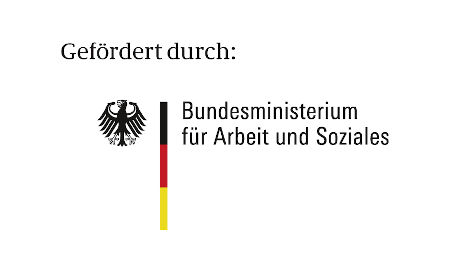CAUSA-A: Compliance, acceptance and implementation of protective measures against infections in the workplace and the organization of occupational health and safety at work
Research area Labour policy and health | Kerstin Guhlemann | Gudrun Brieden
The new project CAUSA-A, funded by the BMAS, investigates in an interdisciplinary team from a sociological and legal perspective, which new problems employees and OSH actors are confronted with, which support the companies need and which solution strategies could be found, especially with regard to special risk groups.

Federal Ministry of Labor and Social Affairs (BMAS)

Funding Network for Interdisciplinary Social Policy (FIS)
The project aims to gain insights into the compliance, acceptance and implementation of occupational infection control measures prior to SARS-CoV 2 on the one hand and the necessary adaptations of occupational health and safety to the pandemic-related changes in work situations on the other. An organization of occupational health and safety that is firmly anchored in operational processes is considered a fundamental basis for its effectiveness and compliance. Especially in times of crisis, this in turn depends on the cooperation of the relevant company stakeholders (managers, employee representatives, company physician, safety specialist FA, and possibly ASA).
It is to be investigated to what extent these actors are aware of their respective roles/responsibilities, in particular for risk groups, and the partly new duties in the course of the pandemic and implement them within the framework of cooperative working practices (among other things through delegation and documentation). On the part of the employees, participatory, co-determined and transparent design of measures are regarded as decisive success factors for understanding and acceptance of occupational health and safety regulations.
In this context, we will examine the extent to which occupational safety and infection control measures have been developed jointly with employees and their representatives and communicated, for example, in the context of instruction. At the same time, opportunities and barriers in the actual compliance with and implementation of the regulations are to be identified, which may depend on psychosocial factors (such as the need for social contacts) and the pandemic-induced progressive dissolution of the boundaries of work. The aim is to highlight successful company strategies, to provide indications of any adjustments that may be necessary in occupational safety and health practices, and to facilitate a sustainable transfer in the form of recommendations for action. The empirical basis for this is formed by a qualitative survey of the various occupational safety and health actors and a quantitative survey of interest groups and their interlinked evaluation by an interdisciplinary project network.
The planned project aims to address the question of safe and healthy working under the influence of the COVID-19 pandemic both inside and outside the workplace (mobile work / home office). In order to ensure this, a chain of preconditions must be observed, the individual aspects of which and their interlinking are the focus of the research efforts pursued here. The successful implementation of the necessary protective measures for occupational health and safety and infection control is based on a functioning organization of occupational health and safety that is capable of acting and adapting, on the one hand, and on the acceptance and compliance of the employees, on the other.
Accordingly, the project addresses protective measures against infections in three directions:
Company: Here, compliance refers to the observance of legal regulations, guidelines and voluntary codes by the company and its employees. The aim is to avoid breaches of the rules by means of a structure of measures ("compliance management system") that is sustainably developed at all levels of the company and whose controlling is intended to ensure compliance with the rules throughout the company. This is achieved when the principles are also lived out in the actual actions of those responsible for the company at all management levels. Especially in times of crisis, effective compliance depends on the cooperation of the relevant company stakeholders (managers, interest groups, occupational health and safety system). It should be investigated to what extent these actors are/become aware of their respective roles/responsibilities, especially for risk groups, and the partly new obligations in the course of the pandemic and implement them within the framework of cooperative working practices (including through delegation and documentation).
Employees: Acceptance is a subject-related concept. Persons, here: the members of a workforce, voluntarily recognize something (someone, situations, facts) and attach significance to it for their own actions. There is an active component in acceptance, insofar as something is not merely tolerated, but there is an approving value judgment. Participatory, codetermined and transparent design of measures are regarded as decisive success factors for the understanding and acceptance of occupational health and safety regulations on the part of employees. In this context, we will examine the extent to which occupational safety and infection control measures have been developed and communicated jointly with employees and their representatives. At the same time, opportunities and barriers in the actual compliance with and implementation of the regulations are to be identified, which may depend on psychosocial factors (such as the need for social contacts) and the pandemic-related advancement of the dissolution of work boundaries, among other things.
Occupational health and safety: Even though human-centered design and continuous improvement of work or safe and healthy work systems can be attributed to the compliance system, we have a separate focus on structures and processes of occupational health and safety. The BAuA has determined that digitization is increasingly shifting the implementation of occupational health and safety to the employees themselves, which is why new support services are needed. This also changes the conditions for action and requirements for experts in institutional occupational health and safety. The pandemic also makes (new) scenarios conceivable: For example, known occupational health and safety deficits may gain visibility through Corona (due to greater sensitivity to health in general) or known acceptance problems may be exacerbated by Corona (Now even more prohibitions). It is therefore necessary to ask about the nature and implementation strategies of infection control measures as well as the successes (also for home office and mobile employees).
It has become clear that business as usual leaves too many obvious problems unsolved and that the occupational health and safety system itself must gain flexibility and adaptivity. Moreover, the pandemic is expected to permanently change the world of work. This particularly affects the areas of increased digitized and autonomous work, where the greatest weaknesses of the OSH system were already visible before the crisis. Against this background, CAUSA-A is investigating the following questions, among others:
- What are the implications of the Corona crisis for everyday work?
- Do the crisis conditions change the effectiveness, topic priorities and cooperation of the various actors in the company's occupational safety and health organization?
- What competencies, instruments and action strategies do the actors need for this purpose or (how) do their views and action practices have to change?
- How can acceptance of corona prevention be achieved among employees?
- How do forms of employee participation change? How can their personal responsibility be strengthened without creating new burdens?
- What form does co-determination and employee involvement take?
- How have risk groups been defined in practice? What procedure was used to identify these persons?
- What company routines for pandemic prevention have already been developed (e.g., instruction and occupational health precautions to protect persons at particular risk)?
- How can preventive occupational health and safety be effectively implemented in the future?
The questions pursued in the project are intended to contribute to a causal investigation of the chain from the recognition of the need for action to the successful implementation of appropriate measures, and to identify problems and approaches to solutions in the individual areas of action. The aim of the project is to highlight successful operational strategies, to gain indications of any adjustments that may be necessary in occupational health and safety activities, and to facilitate a sustainable transfer in the form of recommendations for action for a successful occupational health and safety organization.
By answering these research questions, the project aims to contribute to crisis-proof occupational safety and health by identifying problems and showing ways to solve them. In addition to very specific solutions to the current challenges posed by the pandemic, strategies will be identified and measures described that will enable safe and healthy working in the post-pandemic period and rapid responses to upcoming challenges.
To address the questions, a method triangulation is used that interlinks the results of an explorative telephone survey (n=30) with various occupational safety and health stakeholders and those of an online survey with representatives of at-risk groups (n=100) to generate new insights for the fields of sociology of work, labor policy labor and social law, and labor science.
The explorative survey, conducted in cooperation between sfs and DoFAPP, will be conducted by telephone and guided. The aim is to look for the main solutions or alternative options of the activities of the institutional occupational health and safety during the pandemic and the reactions, expectations and activities of the employees. The solution space is opened up through the actors' options for action and the background questions "Why (not)? How? And when?" are in the foreground. In addition to the successfully implemented measures, the focus is on the solutions that have not been realized and the barriers that have arisen, as well as problems and areas for action. Semi-structured, problem-centered guidelines will be used. The target groups for the survey are occupational safety and health experts, company and inter-company safety specialists, company physicians, employees, works councils, managers and owners from companies in various sectors and of various sizes. The evaluation of the material is software-supported and based on the grounded theory method.
After the evaluation, the results of the explorative interviews and the findings of the online surveys will be correlated. The interlinking of the results is based on the category scheme that emerged in the qualitative evaluations and the phenomena that emerged as well as the results theses of the quantitative investigation. The aim is to cross-validate the results and to use the strengths of each method to complement the results of the other. In this way, findings from the qualitative surveys can be quantified and quantitative results can be embedded in a broader context of meaning and causally linked. In the thematic areas of the identified categories, theses generated from the quantitative evaluations can be compared with each other and consistencies or contradictions can be identified, the verification of which can in turn be carried out on the basis of the qualitative material, or which can serve as guiding questions for outstanding qualitative surveys On the basis of these results, it can be worked out for the problem definition at which points approaches and procedures in occupational safety and health have worked particularly well and at which points challenges and unsolved problems can be identified accordingly. Recommendations for action are then derived from the results of the triangulation.




![[Translate to English:] [Translate to English:]](/storages/zentraler_bilderpool/_processed_/a/f/csm_Kontakt_b86e8d8ecc.png)
![[Translate to English:] [Translate to English:]](/storages/sfs-sowi/_processed_/6/c/csm_Glasfront_sfs_Header_eae6d325d3.jpg)